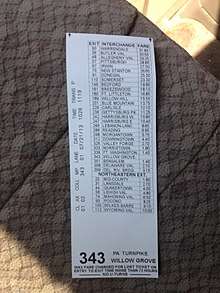Ticket system

A ticket system toll road (also known as closed toll collection system, as opposed to a flat-rate toll road, is utilized by some state toll road or highway agencies that allows a motorist to pay a toll rate based on the distance traveled from their origin to their destination exit.
The correct toll rate per user is easily determined by requiring all users to take a ticket from a machine or from an attendant when entering the system. The ticket prominently displays the location (or exit number) from which it was dispensed and a precomputed chart of toll rates with a list of all exits on one axis and various sizes of vehicles on the other axis. Upon arrival at the toll booth at the destination exit, the motorist presents the ticket to the toll collector, who determines the correct toll. If no ticket is presented (i.e. the ticket is lost), generally the highest possible toll is charged.
First employed on the Pennsylvania Turnpike when it opened in 1940, it has been utilized on lengthy toll highways in which the exits are spread out over a distance on an average of 7 to 10 miles (11 to 16 km) per exit. Flat-rate highways, on the other hand, have mainline toll booths placed at equal distances on the highway, with ramps, depending on the direction of travel, having either coin or token-drop baskets or toll barriers or no barriers at all.
Highways that use the ticket system
- New Jersey Turnpike — entire length including Pearl Harbor Extension and Newark Bay Extension, except for the part of the eastern spur north of exit 16; also note that the northernmost service area (Vince Lombardi) is outside the ticket system (and because it serves both north- and southbound traffic, it is possible to access that service area toll-free).
- Pennsylvania Turnpike — between Warrendale Main Line Barrier and Neshaminy Falls Main Line Barrier on East-West Main Line and between Mid-County and Wyoming Valley interchanges on Northeast Extension
- New York State Thruway — between New York Route 17 and Buffalo (including Berkshire Section) and between Buffalo and Pennsylvania State Line (Erie Section).
- Kansas Turnpike — entire length
- Ohio Turnpike — entire length
- Indiana Toll Road — between Portage Toll Plaza and Eastpoint Toll Plaza
- Florida's Turnpike — between Lantana Toll Plaza and Three Lakes Toll Plaza
- Turner Turnpike and Will Rogers Turnpike in Oklahoma — both use a modified ticket-based toll collection system that places only one mainline toll plaza on the highway, roughly halfway through the length of the road. Under this system, traffic exiting before reaching the mainline toll plaza pays at the exit. Also, traffic entering at said interchange heading away from the mainline toll plaza pays before entering the highway, but traffic entering heading toward the mainline toll plaza receives a ticket. Traffic heading away from the mainline toll plaza that exits before reaching the end of the toll road turns in their receipt they received when paying their toll and receives a refund for the unused portion of the toll roads.
Highways that formerly used the ticket system
- Massachusetts Turnpike — between New York State Line and Exits-14/15 (replaced by an open road tolling system on 10/28/2016)
- A1 motorway (Slovenia) between Ljubljana and Koper before 2008, when Slovenia introduced the vignette system.
- Maine Turnpike between York and Augusta.